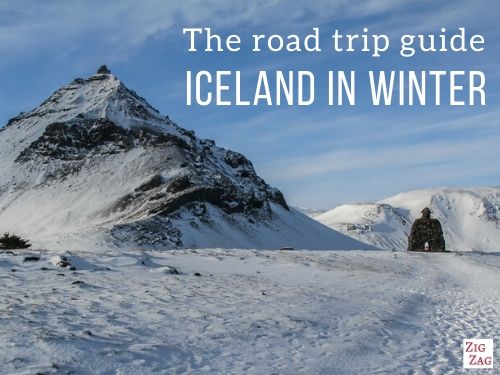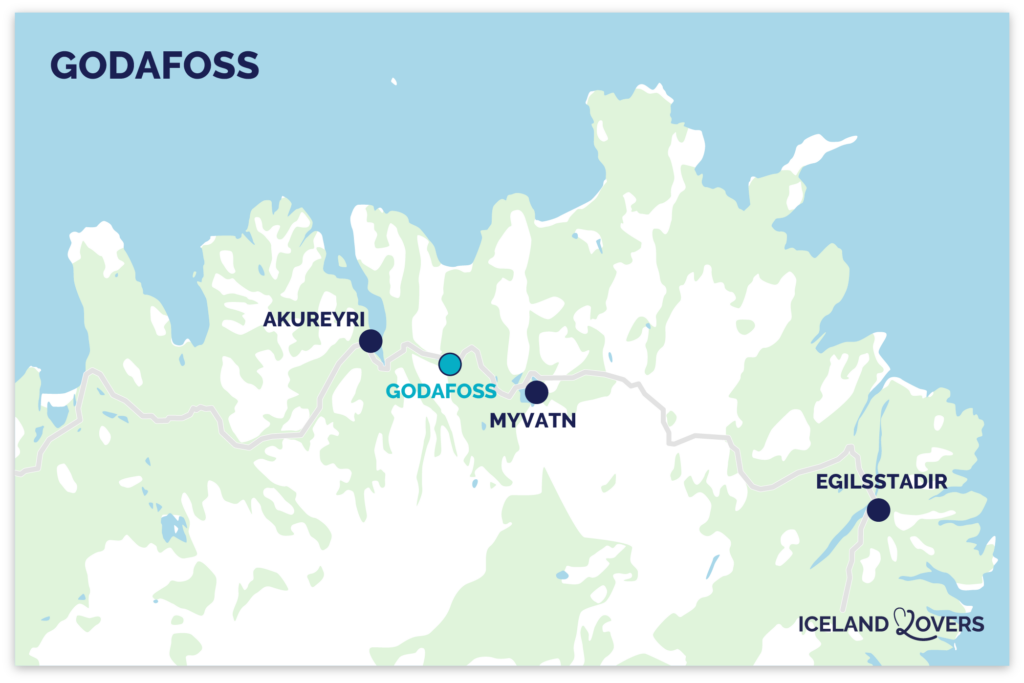A major attraction in northern Iceland, the Godafoss waterfall in winter offers a fairytale spectacle of intense colors and numerous ice stalactites.
Here are some useful tips to help you prepare for your visit and have a wonderful time!

This opinion is completely independent, based on our experiences. We visited the region anonymously, making our own choices and paying our bills in full.
Content
Is Godafoss waterfall worth a visit? Our opinion:
Godafoss is well worth a visit in winter. The waterfall is transformed into a winter wonderland, with stalactites forming around its edges as the water continues to rush in at an impressive start. Admire the contrast between ice, snow and water. What’s more, the intense blue hues of the water against the snowy landscape are equally enchanting. It’s an easy stop along Route 1.
It’s one of the most beautiful places in Northern Iceland, and one of the most beautiful waterfalls to see in winter.

OUR GUIDE TO PLANNING A Dream trip
- 6 maps that make planning easier
- + 75 pre-selected locations
- Practical advice
- + 115 photos to help you choose

How to get to Godafoss in winter: access and map
Where is Godafoss in Iceland?
- In northern Iceland
- Driving time from Akureyri: 30min
- Driving time from Myvatn: 40min
- Driving time from Reykjavik: 5h20
- Here is a map to help you find your way:

RENTING A CAR IN Iceland
Discover the best offers on Discovercars, our preferred platform!
On Route 1, no 4WD required, off Route 1, it depends on your plans.

How to get there? Winter access road
Godafoss is a stop directly along Route 1, which circumnavigates Iceland.
It’s very easy to get to. In winter, Route 1 is usually quickly cleared. But there are fewer cars than in the south, so the ground layer melts less.
Normally, the roads are cleared quickly enough for access. But during snowstorms, roads may be closed at the last minute – always check the status of roads on Umferdin.

Parking
There’s a petrol station.
There’s a large parking lot close to the buildings, on the east side of the waterfall. The parking lot on the west side is not clear.
WHERE TO STAY IN Iceland
Our independent picks for the accommodation of your dreams:
- Where to stay in Iceland (coming soon)
- Where to sleep in Reykjavik (coming soon)
- Best 5-star hotels (coming soon)
- Where to sleep on the South Coast (coming soon)
- Where to sleep on the Golden Circle (coming soon)
- Where to sleep on the Snaefellsnes peninsula

Useful tips: duration, schedules, difficulties…
Best time to visit, opening hours and prices
Godafoss waterfall is along Route 1. So you can visit it on your road trip, depending on when you arrive.
It’s fascinating at any time of day, but particularly beautiful at sunset (looking west) or under the northern lights.
But you’ll have fewer people around you if you come early in the morning or late in the day.
Access is free and possible at any time.

Length of visit and main difficulties
It’s about a 5-minute walk from the parking lot to the last platform, with a staircase. Above all, keep well clear of the barriers. With the snow, you can’t see the dangers of the surrounding areas.
Allow 30min to 45min to enjoy the place.
The path is marked and the snow packed. The stairs/slope are particularly slippery.
Be careful, with snow and ice on the ground, it can be slippery. We recommend you always carry cleats with you to add to your shoes. See our article on winter packing (coming soon)
Catering, Toilets and Facilities
Snacks and toilets at the gas station. You have to pay to use the toilets.
UNFORGETTABLE ACTIVITIES IN winter
- Visit an ice cave
- Glacier hiking
- Whale watching (from Reykjavik, Husavik or Akureyri)

View from Route 1

If you arrive from Lake Myvant, and east on Route 1, you can’t miss the place. In the middle of the great white spaces, you’ll notice a yellow house and blacker rocks.
As you can see, unlike the southern waterfalls Skogafoss and Seljalandsfoss, this one is much lower. But don’t worry, it’s well worth a stop, as it offers a different experience.
Along the Skjalfandafljot river

From the parking lot, the trail takes you up a few hundred meters along a river.
Skjálfandafljót is, in fact, Iceland’s fourth longest river. It is 178 kilometers long, from its source at the northwestern edge of the Vatnajökull ice cap to its mouth in Skjálfandi Bay in the north.
The river is best known for its waterfalls: Godafoss is the most famous, but there’s also Hrafnabjargafoss and Aldeyjarfoss, among others. But they’re not as accessible (route F).

At the Godafoss gas station, there’s a pedestrian footbridge and a road bridge to the other side of the river.
The road bridge has been an important part of the local infrastructure for almost a century, improving access to the area and the famous waterfall. It was built in 1930.
View of the waterfall from afar

All along the trail you’ll enjoy beautiful views. And, after a minute, you finally see the waterfall in the distance.
As you can see, it’s not very high, but the winter scenery is enchanting and the river flows with a good flow!
Water from the Skjálfandafljót River flows from this curved cliff, falling some 12 metres (39 feet) into the basin.
Subscribe to our Newsletter
- Get away from it all with Region Lovers’ beautiful destinations!
- Once a month
- Advertising-free
View of the Godafosss waterfall in the snow

The first platform is the best for admiring the beauty of Godafoss.
This waterfall is renowned for its distinctive horseshoe shape. It is around 30 meters wide and divided into two main sections by a central rock formation.
It’s a fascinating sight, especially with the white calm of the uninhabited landscape all around!

From this platform you can clearly see the stalactites forming on its edges despite the flowing water. The combination of water rush and frozen formations creates a fascinating contrast. This is one of Iceland’s most dramatically changing waterfalls in winter.
The stalactites can become very long, along the 12-metre drop. This makes the views of the waterfall very dramatic, creating visual effects.
Godafoss stalactites vary in size and shape according to temperature fluctuations, making every winter visit unique.
Above the waterfall

You can walk a few more meters to a final platform.
This is just above the cliff where the waterfall falls.
You can clearly see the river flowing above and then below.
Note the color of the water in the photos. During the colder winter months, the water tends to take on a beautiful blue and gray hue. This creates a striking contrast with the snowy surroundings and icy formations (it’s browner in summer, when there’s more sediment). The river’s glacial origin contributes to its changing colors throughout the year.

From this platform, you’ll also have great views of all the details of the waterfall: the stalactites, the chunks of snow ready to fall into the basin, and the little nooks and crannies where the water flows between the chunks of ice.
Nature is truly magical!
Other waterfall: Geitafoss

Downstream from Godafoss, along the river, you can also see a smaller, narrower waterfall (approx. 5 m high). It’s less impressive but just as charming in the snowy landscape. It’s called Geitafoss. It is particularly visible from the pedestrian bridge.
Things to do around Godafoss in winter
From Godafoss, you’re not far from Lake Myvatn and its main winter attractions:
- Skutustadir, with its pseudo-craters (35 min drive)
- Dimmuborgir, an impressive lava field (40 min drive)
- Myvatn Nature Baths (45 min drive)
- Hverir, fascinating geothermal zone (50 min drive)
Frequently asked questions
What does Godafoss mean?
The word Godafoss means “waterfall of the gods” in Icelandic. The name appeared in 999 or 1000, when Christianity was declared the official religion of Iceland. Following this decision, the local legislator threw his statues of pagan Nordic gods into the waterfall.
Is it safe to visit Godafoss in winter?
The site is well equipped and generally safe. However, please take care due to the icy conditions. Stay on designated trails and observation areas, and wear appropriate winter footwear with good traction.
PLAN YOUR TRIP TO iceland IN WINTER
- Best of
Iceland’s winter landscapes
Best things to do in Iceland in winter
The most beautiful waterfalls
Ice caves
Best excursions from Reykjavik

- Practical advice
Getting around (coming soon)
How to rent a car in Iceland
Winter driving tips
Where to stay in Iceland in winter
Itineraries: 3 days – 4 days – 5 days – 1 week – 10 days (to come)

- The must-dos
Reykjavik in winter
Golden Circle in winter
South coast in winter
Snaefellsnes in winter
Silver Circle in winter (coming soon)
Lake Myvatn in winter
Eastern Fjords in winter
Seljalandsfoss in winter
Jokulsarlon in winter




